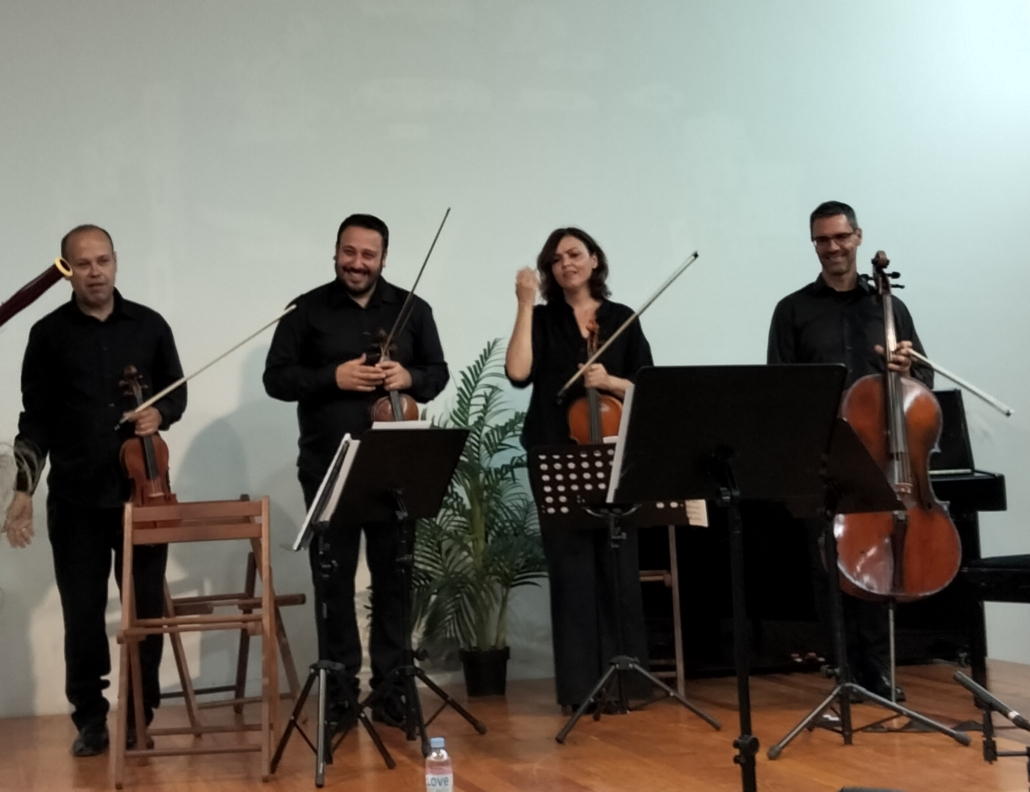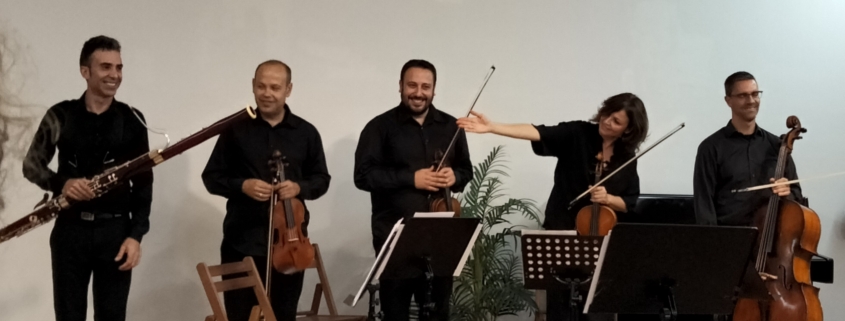BEAUTIFUL BASSOON DANCES ON STRINGS
BEAUTIFUL BASSOON DANCES ON STRINGS
by Norman Warwick
Some musicologists would say that the word bassoon, for an instrument that is sometimes also known as a “fagotto” originated in the French language? It is said that the name “fagotto” is derived from “fagottez”, which is French for “a bundle of two wooden sticks.” As the same word also exists in Italian, it is also said that the name originates from this Italian term instead.
Wherever it´s name originated from, a bassoon made a name for itself on Lanzarote recently. It was played when Miguel Diaz collaborated with the Quarteto de Cuerda Ornatis at El Fondeadero in Puerto Del Carmen.
Having read the positive comments in island events listings, we sailed the stormy seas and set out on the waterbus that turned out to be a glass bottomed fish-sighting vessel. We had barely got out of the harbour at Puerto Calero before the waves were roaring above the boat,….ok, ok, ….that´s poetic licence,…but it was definitely ´choppy´ and it´s safe to say the twenty five minute trip had its ups and downs.
On wobbly legs the four of us (Dee and I and our two undercover reporters) disembarked on to terra not so firma, and danced the walk of the drunken sailor to the nearest restaurant, La Valeta, nearly twenty yards away. We took the only table for four in the entire place, because the restaurant was laid out beautifully in one long table for forty people. The waitress told us that the party would not be arriving until 8.30 and we asked her if we could have that table for four, drink now, order food at five thirty and be able to leave at 7.30 to cross the road to the concert arena.
We needed this time to reach agreement between us as to how many, and which, of the forthcoming Festival Internacional de Musica Classical de Canaria we would reserve seats for. This is a logistics nightmare for us as we want to hear the concerts, let alone for those who organise a score of orchestras, chamber music ensembles, string quartets, and individuals to deliver a series of several concerts to each of the eight Canary Islands. After our sin alcohol and wine filled discussion we can now promise you previews of all events in the next couple of weeks and reviews of at least four of the events throughout January and February 2024.
We also agreed on a couple of talks we would like to attend about the island geology and various Christmas related events. We would have probably mapped out the whole of 2024 had the waitress not returned with our order at 6.00 pm of risotto for two, garlic prawns for a third and fried cheese and marmalade and chips para mi.
The apple tart and the cheese cake were pretty damned good, too. Great meal, lovely staff and lots of ticks in all the right places.
We fell into a dua lingua conversation with a lovely couple at the bar but with only one in every twenty words identifiable it was a bit like playing Blankety Blank with Bradley Walsh.
So at seven thirty on the dot we crossed the road, entered the room and took four of the less than usually plush seats. We had time to just idly watch the rest of the audience taking their places and to come to the conclusion that this was an audience of middle – age plus, and we four raised the average age by a few years !!
Miguel Ángel Mesa Díaz was born in Santa Cruz de Tenerife, in 2008. He graduated from Musikene (Higher Music Center of the Basque Country) under the tutelage of teachers David Tomas Realp and Javier Aragó, among others. He has been a member of the JONDE (Spanish National Youth Orchestra) and he was awarded an Erasmus scholarship to study Bassoon at the Universität der Künste Berlin receiving classes from Professor Eckart Hübner (soloist SWR Sinfonieorchester Baden-Baden und Freiburg).
In 2008 Miguel joined the Gustav Mahler Jugend Orchestra, in which he enjoyed working with conductors such as Herbert Blomstedt, Sir Colins Davis, etc in a large number of auditoriums and various halls at European level such as Musikverein (Vienna ), Concertgebouw (Amsterdam), Royal Albert Hall, (London), National Music Auditorium (Madrid), among others.
Since 2008 he has developed a great musical activity as a Freelance in which he has collaborated with numerous orchestras including Castilla y León Symphony Orchestra, Galicia Symphony Orchestra, City of Granada Symphony Orchestra, Bilbao Symphony Orchestra, Gulbenkian Symphony Orchestra (Portugal), Tenerife Symphony Orchestra, Royal Seville Symphony Orchestra, Royal Galicia Philharmonic, Principality of Asturias Symphony Orchestra, Spanish Radio Television Symphony Orchestra and Madrid Symphony Orchestra.
In the period of 2012 – 2013 he occupied the place of soloist bassoonist in the Algarve Symphony Orchestra (Portugal). From 2016 to 2019 he has been a bassoon professor at the Conservatorio Superior de Música de Canarias.
From 2018 to the present, he has been hired as principal bassoon soloist of the Gran Canaria Philharmonic Orchestra.
Since its founding in 2003, the Ornati Quartet has developed important activity, both on stage and in teaching. His repertoire spans all eras, bringing together a deep understanding and total commitment to his performances, including classical recordings, such as José Palomino’s Quintets with Two Violas for the Hispanic Musical Heritage of the Spanish Society of Musicology, to a recent contemporary commission recording the integral of the string quartets of Juan Manuel Marrero. His concerts include, in addition to music for string quartet, and in the 36th Canary Islands International Music Festival with music by Beethoven for the celebration of its 250th anniversary. He has played in other social formats, bringing music closer to people and places in situations of vulnerability or isolation, as well as teaching on specific programs that bring young people closer to art in general.
These musicians, of the stature of Juan Pérez Floristan, Nancy Fabiola Herrera and Rodolfo Mederos, are seeking a balance between the tradition of different styles. They are members of the Gran Canaria Philharmonic Orchestra, where they live and are also regular collaborators of the International Bach Festival,

Tonight Miguel, on bassoon was accompanied by the Quarteto de Cuerda Ornatis and they were introduced to the stage and to warm applause from this audience. So we had before us a bassoonist, three violins and a cello, and no one of the four of us were sure how this might work.
The bassoon is a woodwind instrument that produces sound in a low range, using a double reed, and has a distinctive shape, with a long tube that looks as though it has been folded in two. The musical instruments that could be described as ancestors of the bassoon were developed in the 16th century, and include the shawm, the rankett, and the dulcian (or curtal). All of these are low-pitched instruments that use a double reed. Among them only the dulcian is shaped as though folded in two, making it the musical instrument one could describe as closest in shape to the modern bassoon. In the 18th century, bassoons with three or four keys were the most common. Then, in the latter half of the 18th century, bassoons equipped with 6 keys began to appear. However, the fingering varied depending on the manufacturer, and a standard design had yet to be established. Coincidentally, Mozart’s “Bassoon Concerto” was written during this period.
We would learn, in a brief chat after the show with Miguel, the eye-watering cost of this particular bassoon, and how precious the instrument is to him.
At the most basic level the musical term, string quartet, refers to the medium of four string instruments: two violins, viola, and violoncello. It can also be used to describe the collective identity of the instrumentalists themselves, in particular established professional ensembles such as we had here this evening.

I was surprised to hear that classical music has been composed specifically for bassoon and string quartet, for example Sibelius’ En Saga for flute, oboe, clarinet, horn, bassoon, 2 violins, viola, cello and double bass, Holst’s Egdon Heath.
Until this glorious and uplifting concert I couldn´t hear bassoon and strings in my head and imagined that one was likely to overwhelm the other. Because the players here were so sympatico, so skilled and so happy to be working together, the entire sound gelled perfectly. The two male and one female violinists fell and soared and hovered in tandem and this was particularly noticeable on the Vivaldi piece that was as joyous of any Four Seasons extract I have heard. The cello leant depth and support, and tension, as the instrument will in the hands and at the bow of a great player. Today being the birthday of the particular cellist prompted the promoter to bring Natalia, one of Lanzarote´s most in-demand classical pianists, to the stage just as the musicians entered, to play Happy Birthday to him. This she did in best Les Dawson fashion, and the cellist and his fellow musicians obviously loved it.
They returned the favour perfectly by delivering a concert that amplified and celebrated the bassoon and excellently performed pieces by some of the world´s greatest composers.
After the concert we had a quick word with Miguel and learned he actually learned his first music on saxophone and piano.
Throughout our admittedly short conversation he cradled his bassoon in his arms, and when he told us the price of it we realised just why he was holding it so tightly.




Leave a Reply
Want to join the discussion?Feel free to contribute!